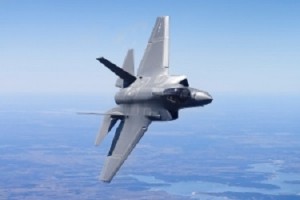Military Connection: Pilots Eye Flying Stealth Jet: By Debbie Gregory
 Navy pilots in Virginia got the first glimpse of the F-35C at Naval Air Station Oceana. But when will they get to fly one?
Navy pilots in Virginia got the first glimpse of the F-35C at Naval Air Station Oceana. But when will they get to fly one?
The F-35C multi-role stealth fighter is the most advanced aircraft in production. But considering budget constraints, as well as the F-35 Lightning II’s current price tag (up to $116 million per aircraft) production has been delayed several times. Since the first F-35 was unveiled in 2006, the program has been grounded more than a dozen times for various reasons and issues.
There are five major variations of the F-35:
The F-35A is intended for use primarily by the U.S. Air Force. It is the most well-rounded type, as it is lighter, faster and smaller than the others. Without the additional modifications of the other models, the F-35A is equipped for conventional take-offs and landings on a traditional runway. The U.S. Air Force is slated to buy 1,763 F-35A’s.
The F-35B is modified for vertical takeoffs. This model is similar in size to the F-35A model, but the fuel capacity is about one-third less. The F-35B model is intended for use by the U.S. Marine Corps, who intends to purchase 340 of them.
The F-35C is modified for use onboard aircraft carriers. This model has a wingspan of 43 feet versus 35 on the A and B variants. With larger wings and larger tail control surfaces than the other models, the F-35C is built to take off and land on the short runways of naval carriers. The wing tips of the F-35C are also designed to fold, leaving more room on a ship’s flight deck. This variant also carries over a thousand more pounds of fuel, allowing for a range of 1,400 nautical miles over the A-type’s 1,200. The U.S. Navy has planned to buy 480 F-35C’s.
The F-35 is the fifth generation of stealth aircraft, but its capabilities are well beyond those from earlier generations. The F-35 has cameras built into the hull, which offer a 360-degree view for pilots. Along with the enhanced view, pilots can target contacts simply by looking at them.
Another feature that the F-35 possesses is the ability to store ordinance in bays built into the wings of the aircraft. Older generations housed ordinance on the wings. The F-35 feature assists with the aircraft’s ability to avoid being detected by radar.
While many politicians, military officials and taxpayers have been troubled by the F-35 program’s rising cost and delays in production, pilots around the U.S. military are salivating at the chance to fly them.
While seven military bases have already begun training programs for pilots, it could be a several years before the F-35 begins its designed purpose of replacing older platforms in the USAF, USMC and USN fleets. And it could be a decade before the aircraft are combat-ready.
Military Connection proudly serves those who serve in the Army, Navy, Air Force, Marines, Coast Guard, Guard and Reserve, Veterans and their Families. We are the go to site for Veteran Employment and information on Veteran education. Militaryconnection.com provides Veterans with and Directory of Employers, a Job Board, information on the Post-9/11 GI Bill, and a blog that offers Veterans boundless information. Be sure to visit Militaryconnection.com, the go to site.
Military Connection: Pilots Eye Flying Stealth Jet: By Debbie Gregory

















